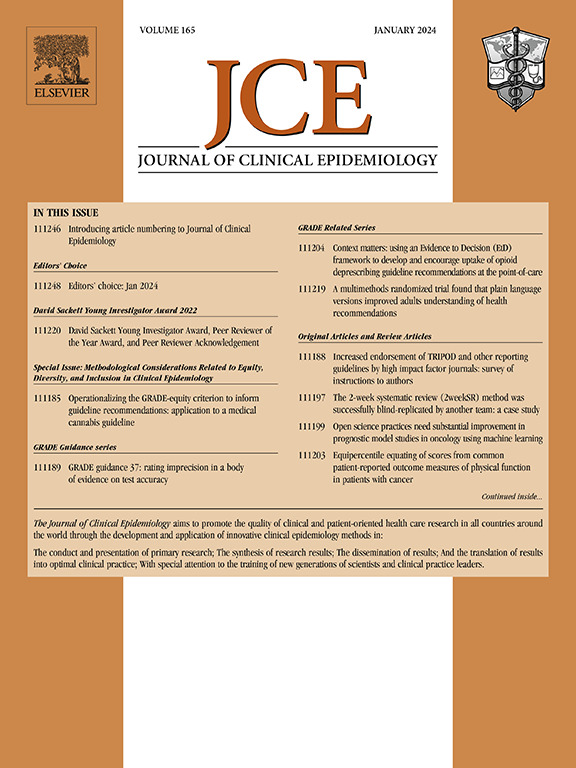受试者信息宣传单中对受试者数据和生物样本的使用说明不足。
IF 7.3
2区 医学
Q1 HEALTH CARE SCIENCES & SERVICES
引用次数: 0
摘要
背景和目的:随着临床试验完成后参试者数据和生物样本库的可用性越来越高,向参试者充分描述未来的数据和生物样本再利用计划变得越来越重要。我们评估了试验团队目前如何在参与者信息单(PILs)中描述参与者数据和生物样本当前和未来的使用情况:方法:对爱尔兰和英国的 240 份 PIL(182 项临床试验)进行回顾性定性分析。采用四阶段实用内容分析法对数据和样本的使用/再使用进行提取和分析。同时还制定了一份建议清单,列出了试验团队在设计 PIL 时需要解决的问题:在纳入的 240 份 PIL 中,85% 的 PIL 特别提到或直接暗示了如何维护参与者数据的机密性;38% 的 PIL 被作者认为充分描述了如何维护数据的机密性(即 PIL 特别提到了数据去标识化和遵守数据保护法规);47% 的 PIL 报告了数据的预期存储期限(平均 15 年;标清 ±9 年);40% 的 PIL 明确说明了数据是否会用于未来的研究,28% 的 PIL 说明了数据是否会与其他研究人员共享。在 117 份说明将从参与者处采集生物样本的 PIL 中,80% 提供了要求采集样本的原因,66% 说明了储存的样本是否会去标识化,21% 说明了是否会向参与者提供个人层面的结果,70% 说明了样本是否可用于未来的研究。在 73 份说明未来样本储存计划的 PIL 中,18% 说明了计划的储存期限,48% 说明了样本是否会与其他研究人员共享。试验团队在设计 PIL 时应注意八个建议问题,如 "当前研究的数据和样本存储计划持续时间是多长?结论:PIL 通常没有详细说明当前使用和未来再使用参与者数据及其生物样本的计划。大多数 PIL 没有充分说明数据保密计划。需要采用最佳实践方法,在 PIL 中说明数据的使用和再利用情况。这需要多方利益相关者的参与,包括潜在的试验参与者,才能取得进展。本文章由计算机程序翻译,如有差异,请以英文原文为准。
Use of participant data and biological samples is insufficiently described in participant information leaflets
Background
With greater availability of participant data and biobank repositories following clinical trial completion, adequately describing future data and biological sample reuse plans to trial participants is increasingly important. We evaluated how trial teams currently describe current and future use of participant data and biological samples in participant information leaflets (PILs).
Methods
Retrospective qualitative analysis of 240 PILs (182 clinical trials) in Ireland and the UK. Descriptions of data and sample use/reuse were extracted and analyzed using a 4-stage pragmatic content analysis approach. A recommended list of questions to be addressed by trial teams when designing PILs was developed.
Results
Of the 240 included PILs, 85% specifically mentioned, or directly implied, how confidentiality of participant data would be maintained; 38% were considered by the authors to adequately describe how data confidentiality would be maintained (ie, the PIL specifically mentioned data deidentification and compliance with data protection regulations); 47% reported the intended duration of data storage (mean 15; SD ± 9 years); 40% specified if data would be used in future research studies and 28% stated if data would be shared with other researchers. Of the 117 PILs stating biological samples would be collected from participants, 80% provided a reason for requesting the sample, 66% stated whether stored samples would be deidentified, 21% specified if individual-level results would be made available to participants and 70% specified whether samples may be used for future studies. Of the 73 PILs specifying planned future sample storage, 18% stated the intended duration of storage and 48% specified if samples would be shared with other researchers. A list of 8 recommended questions to be addressed by trial teams when designing PILs were identified, for example, ‘What is the intended duration of data and sample storage for the current study?’.
Conclusions
PILs often provide insufficient detail regarding plans for current use and future reuse of participants’ data and their biological samples. The majority do not adequately describe plans for maintaining data confidentiality. Best practice approaches to describing data use and reuse in PILs are needed. This will require multistakeholder input, including potential trial participants to progress this.
求助全文
通过发布文献求助,成功后即可免费获取论文全文。
去求助
来源期刊

Journal of Clinical Epidemiology
医学-公共卫生、环境卫生与职业卫生
CiteScore
12.00
自引率
6.90%
发文量
320
审稿时长
44 days
期刊介绍:
The Journal of Clinical Epidemiology strives to enhance the quality of clinical and patient-oriented healthcare research by advancing and applying innovative methods in conducting, presenting, synthesizing, disseminating, and translating research results into optimal clinical practice. Special emphasis is placed on training new generations of scientists and clinical practice leaders.
 求助内容:
求助内容: 应助结果提醒方式:
应助结果提醒方式:


